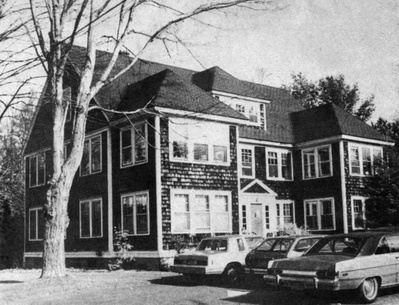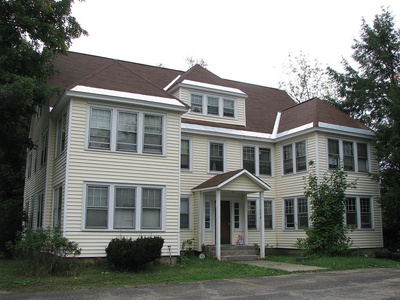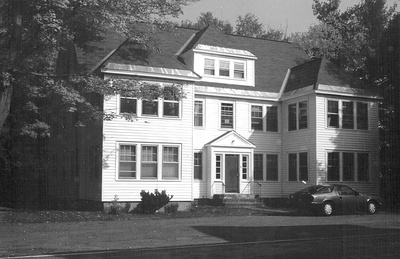 Lent Cottage. Adirondack Daily Enterprise,
Lent Cottage. Adirondack Daily Enterprise,
 Lent Cottage, 200Address: 114 Franklin Avenue
Lent Cottage, 200Address: 114 Franklin Avenue
Old Address: 18 Franklin Avenue
Other names: Jennings Cottage, Delscamp Cottage (1928), Desartis Cottage (1928), Bligh Cottage (1934); DIS
Year built: about 1920
The Lent Cottage was an apartment house designed originally for curing, each apartment has two bedrooms and a nine by thirteen-foot cure porch. It was built by Simon Ades, himself a TB patient from Baltimore; on his death, it passed to his nurse, Corneilia L. Nourse. In 1925, it was owned by Dr. Malcolm Lent, a TB specialist. Between 1925 and 1933, it was registered with the T.B. Society by a Mrs. Jennings. Dr. Lent sold the property in 1933.
Adirondack Daily Enterprise November 11, 1982
Helen Hill was hill of hope
By PHIL GALLOS
 September 1991
September 1991 September 1991Clinton Avenue, Franklin Avenue, Shepard Avenue, Front Street, Helen Street, Park Place: the streets of Helen Hill.
September 1991Clinton Avenue, Franklin Avenue, Shepard Avenue, Front Street, Helen Street, Park Place: the streets of Helen Hill.
Some people cynically referred to it as "hemorrhage hill," but for countless others it was a hill of hope. Along its streets stood the greatest concentration of private sanatoriums and other cure related facilities in Saranac Lake.
There were "nursing" and "up" cottages, there was Mary Prescott's Reception Hospital; there were private homes for families with a curing member, and there were apartment houses for those families as well. Of the latter, the Jennings Cottage at 18 Franklin Ave. is a superb example and a very fine structure in its own right. Many cure buildings in Saranac Lake have changed radically over the decades. Some were not built to house tuberculosis patients originally. Some were, but the demand for space outstripped their design. Whichever the case, these buildings often grew by random accretion — a porch added here, a wing there, another porch somewhere else, etc. Such houses, the primary structure of which is sometimes completely obliterated, range in appearance from inspired to hideous.
Following changes wrought by the demands of the curing industry came changes wrought by conversion to apartments and, finally, changes in the name of energy efficiency.
In fact, so many of the multi-family homes in Saranac Lake have been modified, that a building which has stood essentially unaltered since its construction is the exception rather than the rule.
One of the exceptions is 18 Franklin Ave.
Its history is no longer completely clear, small and large pieces having vanished with the people who lived it.
The building was apparently built in the early 1900s by a man who was ill with tuberculosis. When he died, he left the house to his nurse. There is one entry dated 1925 in the files of the Saranac Lake Voluntary Health Association that lists 18 Franklin as belonging to a Mrs. Jennings, hence "Jennings Cottage."
The Jennings Cottage is one of those structures designed and built to house tuberculosis patients. There are four tenant apartments, two on each floor, and a caretaker's apartment. All have two bedrooms, and all but the caretaker's have a cure porch attached to the master bedroom. Between the porches and the bedrooms are extra-wide doorways with no sills. This allowed a bed to be easily rolled from bedroom to porch and back. It is a common feature of cure cottages.
Somewhat less common are the sash windows on the porches, seven on each porch, identical to those on the rest of the building. This, coupled with the fact that the porches are an integral part of the structure rather than additions, gives the Jennings Cottage a strength of line, a visual unity that is a pleasure to behold. There is an impressive straight-forewardness here that is a bit unusual.
Quite unusual are the porches' dimensions — 9x13 feet — very large for a single occupant cure porch. But this is a large house with apartments generously proportioned. The bathroom in the caretaker's apartment is as spacious as many a Saranac Lake bedroom.
Eventually, the Jennings Cottage became the property of Dr. Malcolm Lent. It passed from him to John Corbett of "Pine and Corbett," proprietors of the famous Riverside Inn which stood by Lake Flower at the corner of Main and River Streets.
After John Corbett's death, 18 Franklin was administered by the Corbett Estate.
On November 10, 1940, Mr. and Mrs. Sam Sherman moved in as tenants. At that time, Mr. and Mrs. Jerry Pasho lived in the caretaker's quarters on the third floor. Theirs were the myriad responsibilities inherent in maintaining a large building. Not by any means least of these was keeping it comfortable in winter.
In the basement were a coal furnace and hot water heater. They demanded attention. Every morning at five o'clock one would have to descend three flights of stairs to grab a coal shovel and feed the fire boxes and return various times throughout the day. Feeding amounted to a carload of coal each winter.
After being tenants for seven years, the Shermans bought the Jennings Cottage and moved to the third floor. Six months later, they converted to oil-fired heat and hot water. They installed aluminum, combination storm windows, and, one by one, they put radiators on the porches. These are the only major alterations that have been made at 18 Franklin Ave. None significantly affect the building's appearance. Mrs Sherman is the current owner. She still lives on the third floor.
While institutions like Trudeau and the classic cure cottages like Sageman's and Werle's form the popular image of Saranac Lake as a health resort, single family homes and apartment houses were equally vital though less known
It was early apparent to the medical community in Saranac Lake that a patient's emotional condition had a crucial impact on his or her chances for recovery, and the relationship between patient and family had obvious bearing.
Often these relationships were heartwarming, sometimes heroic. Far too often they were tragic.
Especially prior to the 1930s, the very word "tuberculosis" was almost supernaturally repulsive. Association with the infected was scrupulously avoided and, if it could not be avoided, certainly not acknowledged. The situation amounted to a virtual taboo which held sway in most of the "civilized" world.
This led to much familial anguish. When it was learned a family member had tuberculosis, it was as though the entire family had been stricken; and there arose as many opportunities for cruelty as for love. The cruelty began with suppression and culminated with rejection so total that even after the stricken member had recovered he or she might not be welcomed back into the family — ever. A trend was noticed at Trudeau in which certain patients, after being told they could go home, would become ill again, over and over. One went through the cycle seventeen times — until she married another former patient. To those people, the memory of how things had been at home was more horrible than having the disease. If, though, the relationship between patient and family was positive, the understanding and selfless support of loved-ones was seen to be a powerful adjunct to the curing process. These families were encouraged to stay together. Buildings like the Jennings Cottage provide the needed space.
Whether they were with their families or not, those who came to Saranac Lake to cure became members of a greater family, a family called the village.
Many came too late, their disease too advanced, their remains later shipped out of town on the 9:55 night train. For their survivors, Saranac Lake was a name to forget. But for many others, the village was a place of hope unlike any other place, the antithesis of a world of fear and rejection, a community of people, both healthy and ill, in which a man or woman with tuberculosis would not be shunned as a carrier of contagion but would be accepted as a human being.
This may be the most important single reason why so many, having regained their health, are still living in Saranac Lake.
Some of them reside at 18 Franklin Avenue.
Thanks to Frances Sherman, Esther Mirick, and Dr. Gordon Meade for providing information for this story.
In the late 1970 and early 1980s, Nadia Slack lived in the first-floor apartment on the right front in the photo and, as a former patient, still slept out on her porch.
--Mary Hotaling
Sources



